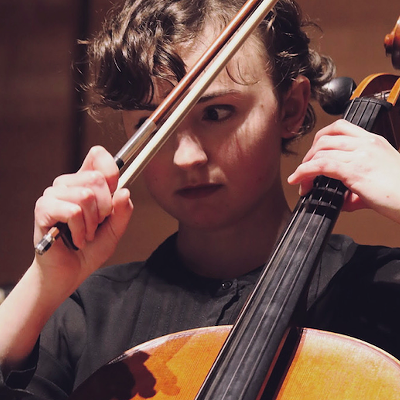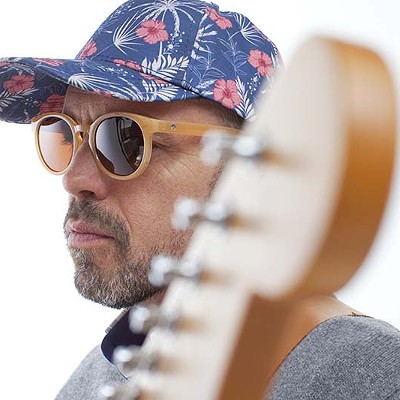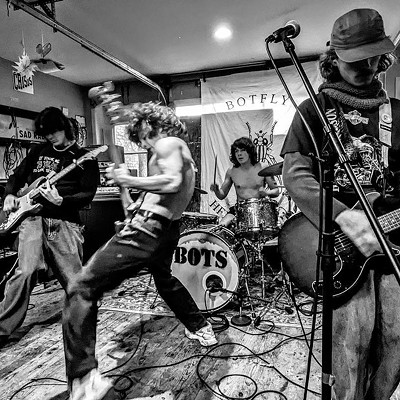Two people meet up on a busy street corner, the traffic a welcome distraction from the tension between them... Decaying buildings stir emotions, making someone wonder why they ever moved back to this place... These are the kinds of everyday occurrences Samson, who lives in Winnipeg, sets against the larger cityscape in a way urban Canadians can immediately recognize and understand.
Look up from the page right now: Maybe you’re sitting on the bus—what are the other people doing as you’re shuttled along? You’re in a coffee shop? Who’s coming in and out the door and what do you hear from outside when the door opens? Change the scene to wherever you are: campus, work, home.
The sights and sounds around you move in and out of your consciousness, connecting you to your city. That’s what Samson achieves: connection in busy places that challenge your ability to connect with your surroundings and with other people.
When so much about urban living can grind us down, artists help ground us and make us at home in our cities: tunes by Joel Plaskett, Jerry Granelli the spectacle Drum! conjure Halifax; new novels from Brit Ian McEwen (Saturday), Dionne Brand (What We All Long For) and George Elliott Clarke (George and Rue) bring you to London, Toronto and Halifax respectively; Alex Livingston’s show at Dalhousie Art Gallery is mediated by a life based in this city.
Don’t go rushing to search Samson’s name in your neighbourhood public library branch or your favourite book shop. He’s worthy of the page, certainly, but Samson’s words combine with some of the most exciting, powerful indie-rock/post-punk of the last couple decades as played by Winnipeg-based quartet The Weakerthans (along with recently added bassist Greg Smith, guitarist Stephen Carroll and drummer Jason Tait).
The Weakerthans, with Toronto’s Constantines, kick off their Rolling Tundra Revue—a cross-country tour with two nights in most stops—in Sydney on March 22. Then it’s on to Halifax for an all-ages show at the Pavilion on Wednesday, March 23, followed the next night by a gig at Reflections.
“I love the intensity, the pitch, the high pitch of cities,” Samson says. “The density and sheer humanity of it all: I like how people are thrown together and forced to live together. That’s exciting to me. Every city has these wonderful, specific quirks about them. I love finding what’s totally original about a city.”
Through thoughtful lyrics and bold music, the Weakerthans invite you to think about your own city, your own experience of it, as you sing along. You live physically in a city, walk its streets and take its buses, but this group offers the chance to sing the intangible part—no less important—into existence.
Not surprisingly, Samson looks to and talks about writers first when considering how artists help people make sense of their city.
“Writers are known for writing about a place, not the actual place, but a reflection in their head of a place,” he says. “You can go to Paul Auster’s New York, Michael Ondaatje’s Toronto. These become real places but they’re not real—mediated in a great way. They distort the reality of a place, that makes it easy for people to see their city in a new way. What I love about Paul Auster is he allows you the space to create your own story. It’s inspiring that each of us has this city inside of us.”
But musicians have done it for him too. Besides calling the Constantines one of his favourite bands right now, Samson fondly recalls an earlier tour, around 1999, he thinks, with Plumtree and how he came to love Halifax—a “foreign landscape” to a Prairie boy. Samson also remembers how Toronto formed in his mind’s eye when hearing Lowest of the Low, featuring Ron Hawkins’ site-specific lyrics, in the early ’90s. (Hawkins, incidentally, is one of the Weakerthans’ earliest champions.)
“I was so excited to meet Ron and those guys. That was a huge thing for me. They talked about those specifics, ‘Under the Carlaw Bridge,’”—a song set in Toronto’s east end, from 1991’s Shakespeare My Butt—“and all those specific sites. Anyone could relate to those places, even if you live in Winnipeg. That’s the power of that kind of writing.”
Samson has shown the same lyrical power since 1997 and the formation of the Weakerthans. An EP, Watermark, and a debut full-length, Fallow, came out on the band’s G7 Welcoming Committee label.
On Fallow, Samson explains, “I had all this stuff I kind of had to let lie—burn the fields. What I wanted to write about, who I wanted to be, and all those big questions. Everyone has to write their ‘you done me wrong’ songs, damn my friends. I kind of tried to get rid of them all on that first record.”
A major theme that courses through the veins of all cities starts to punch through on that first album. It’s that feeling of disconnect, loneliness.
“Alienation has been a main theme of mine forever,” he says, “people trying to communicate with each other is a daunting task in a capitalist society. Music is something that can assist with that.”
Lyrics for every tune get printed on the liners of each album. Sing along to, for example, the first track on Fallow, “Illustrated Bible Stories for Children”: “Morning bright, rise. Go over your lines. Iron your carefully crafted disguise. We’d all like to sing. It’s easy to sigh; to sprinkle a handful of plausible lies. Our buildings will rise, poke out our own eyes. Publicly smile and privately frown.”
The fictional sense of character and story really takes shape on 2000’s Left and Leaving, a seminal record for urban denizens of North America. (The band has toured the US hard and are now signed with Epitaph, a leading US label for punk and post-punk.) You can hear, on this album, Samson finding his voice.
On the title track he sings: “My city’s still breathing but barely it’s true. Through buildings gone missing like teeth. The sidewalks are watching me think about you, sparkled with broken glass. I’m back with scars to show. Back with the streets I know.”
In a few lines, you meet two characters, learn a little about their relationship and their surroundings.
“Left and Leaving” is one of the songs that has made Samson a sort of pop laureate of Winnipeg. Right through 2003’s Reconstruction Site, he’s been dogged by claims he hates his hometown, Winnipeg. Every city has artists in that predicament of pointing to the ills out of a love and hopefulness for the place. On Reconstruction Site, a song, “One Great City!” offers several fictional Winnipeggers’ points of view. Each verse ends with the refrain “I hate Winnipeg.”
“People come up to me in bars and complain about that song,” Samson says. “I’ve stopped worrying about that too much. I have to tell people, I’m not in there. There’s no character in that song that even resembles me.”
Indeed Samson travels to many different places on the latest record. But he still filters his views through his experience of, and love for, Winnipeg. “I use Winnipeg as a blunt tool to talk about a whole bunch of things and a whole bunch of places. On this last record, there’s a song about the Antarctic, and parts of it are set in Paris, and I always think that when I’m writing about Paris I think of a set of Paris built in downtown Winnipeg, like someone’s put it up at Portage and Main so I can write about it.”
Samson’s tone goes wistful, even a little worried, when he talks about the intensity of the upcoming tour. He’s grown up and into his city, his home. He’s comfortable there and he’ll miss it, even though he sees it for its flaws as much as its beauty. Samson names poverty and racism as major motivators for his art and politics.“Cities are a perfect metaphor for larger society. They’re a perfect instrument to think about politics. They have all the greatness and horrors of humans living together,” Samson says. “Thinking about the problems of cities is, to me, a handy way of thinking about bigger problems. Thinking about them on the scale of the street you live on is an easier way to get a handle on them.”
And his views have affected his younger charges on the tour. The Constantines’ Steve Lambke looks forward to the opportunity to get to know the country that two nights in most stops on the tour will offer. “I was just thinking the other day that I wanted to get a Canadian guide book for this tour. It would be fun to have in the van,” Lambke says. “That’s actually one of the most exciting things about this tour. It’s bold: be big, be bold, be brave.”Big, bold, brave: qualities you want in your favourite artists. Because when people embody these qualities it’s an inspiration to all of us to try to make a difference in our own brave way.












